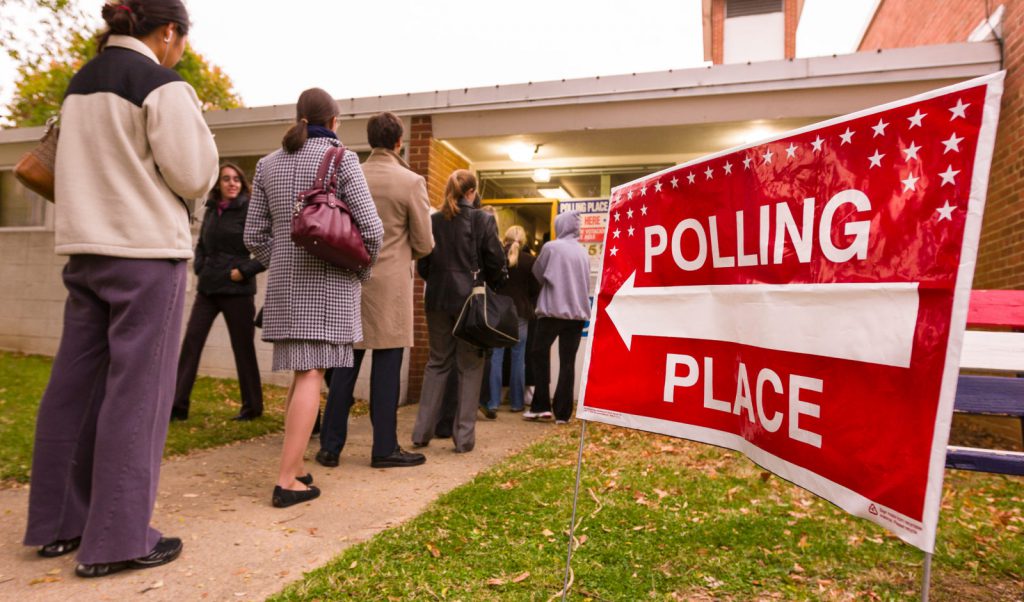
Published October 16, 2018
Everyone recognizes the normally sleepy interlude between presidential races that we call the midterms has energized partisans on all sides, but the wide variation in national polls don’t give us clear guidance on the likely results.
Fortunately, we do have a unique data set to examine that can give us a clear read on where the election stands right now and why.
These data point to a highly nationalized electorate that is deciding to support a party rather than a candidate and using Trump as a proxy for the Republican Party at large. As applied to the specific races, this implies we will experience a mild blue wave in the House but little likelihood of a Democratic tsunami that could also win them the Senate.
A Rare Look
The data set to which I refer is a series of polls in key House and Senate races conducted by Siena College in conjunction with the New York Times. They have so far polled 46 hotly contested House and Senate races in the districts and states that will determine the outcome. Looking at that many polls conducted by the same pollster using the same methodology gives us a rare look under the hood to see the election’s true underlying dynamics.
The polls reveal that partisanship is extremely high regardless of the type of state or district polled. Democrats and Republicans alike say they are between 85 and 95 percent likely to back their party’s candidates in virtually every race polled. Moreover, these levels of support pertain regardless of whether the people polled know anything about the actual candidates. Incumbents are often well known while challengers are not, but astronomical levels of partisan support arise in both sets of cases.
These data can tempt strategists into thinking the real issue is turnout. If a partisan is 90 percent likely to back that party’s candidate, then focusing your campaign on getting as many of these people to the polls as possible seems to be sound strategy.
Don’t Forget the Independents
But this approach, in most cases, would be wrong. That’s because of the role independents play and because of how independents are choosing to cast their ballots in these charged, partisan times.
Independents do not exhibit such uniform partisan patterns, at least on the surface. Independents split their ballots relatively evenly, rarely giving one party’s candidate more than 55 percent. They also tend to back the current leader. The candidate who leads among independents also leads in the overall poll in 32 of the 43 separate House races polled and are tied or within one point in another four. These data suggest that appealing to independents in a way that also attracts partisans is a better way to go.
That cannot be done, however, solely by the individual candidates themselves. The polling data show that the Republican candidate’s total is directly tied to two national measures, Trump’s job approval and the desire to see Republicans control the House. Independents, by and large, are not making judgments based on the individual candidates themselves; rather, they are making judgments about Trump and the GOP and applying those judgments to the men and women actually on the ballot.
We can see this by comparing the Republican candidate’s share of the vote to the share of people saying they think Trump is doing a good job and the share saying they want Republicans to control the House. Republican candidates out poll Trump’s job approval by more than five percent in only three House districts. No Republican candidate anywhere exceeds the share of voters who want Republicans to control the House by more than four percent, and only five of 41 out poll the GOP control share by three percent or more. Simply put, each Republican candidate’s fate is largely determined by national trends over which he or she has no control.
Where Republicans Fall Short
This will come as terrible news to many House Republicans. Republicans currently hold 25 House seats that Hillary Clinton carried. The Times has completed polls in 18 of them. The share of people who want Republicans to control the House is at or below 45 percent in fourteen of them and is over 50 percent in none of them. Even districts that Mitt Romney carried by 15 percent or more, such as Texas’ 7th and 32nd Congressional Districts, exhibit these trends.
Republican incumbents will win a few of these seats where Trump approval and GOP support hovers in the high 40s. But they will lose virtually every other seat if the Times polls are correct—unless support for Trump and GOP control inches up among these voters.
Most of these seats fall into one of two categories. They are either dominated by educated, well-off suburbanites or by Latinos. The data are pretty clear that very few of the educated suburbanites who voted for Romney and Clinton are even open to voting for a Republican this year. The data also show that winning a largely Latino district can only occur if the Republican candidate distinctly breaks with the President on immigration and the wall. That’s what GOP incumbents Carlos Curbelo and Will Hurd have done, and both are running better than national trends would imply.
The data also show that Republicans are falling short among another key group of voters, those who voted for Barack Obama and Donald Trump. The Times has polled in areas with eight of these seats, and the Republican candidate runs behind Trump’s job approval rating in five of them. Seven of the eight candidates also run behind the share of voters who want Republicans to control the House, and the eighth only runs ahead by one percent.
Clearly something is wrong with the party’s or these candidates’ messages when they are worse off than the national trends imply.
The Obama-Trump Factor
The contrast between these two sets of seats speaks volumes about the state of the race. Historically Republican seats show some evidence of old partisan loyalties coming into play, but not enough in most cases to save the Republican. Historically Democratic seats, however, also show some evidence of old partisan loyalties coming into play as Obama-Trump Democrats revert to voting Democratic. This trend also endangers Republicans. The GOP is losing support among people who don’t like Donald Trump, and it is not converting enough of the people who do like him to remain backers of their broader cause. These trends combined mean the party is very likely to lose the House.
These trends do not endanger many Republicans in historically Republican seats that Trump carried, however. The Times has polled 17 of these seats, and the Republican leads in all but two. Trump job approval is normally between 46 and 55 percent here, and pluralities or majorities of voters want Republicans to control the House in all but one. A couple of these Republicans might lose because of the strength of the Democratic candidate, but almost all will win. If this happens on Election Day, that fact essentially places a ceiling on the number of potential Democratic gains. Only 11 Republicans hold Obama-Trump seats; combined with the 25 Republican-held Clinton seats, that means only 36 seats are at high risk of being lost. Since some of these people will survive, it follows that it is very unlikely that Democrats will gain more than 35 seats if the trends from the Times polls hold.
These same trends speak poorly for Democratic Senate chances. Republicans hold only one seat in a state Clinton carried, while Democrats hold five in states both Romney and Trump carried. The Times has not polled any of the latter states, but other polls show Republicans ahead in two (North Dakota and Missouri) and running close in two more (Montana and Indiana).
The Times poll of Nevada shows Republican incumbent Dean Heller narrowly ahead with 47 percent of the vote. Since Nevada uniquely allows voters to select “none of the above,” a candidate does not need 50 percent to win. This seat, therefore, should be considered a toss-up.
Good News, Bad News
Democrats are challenging in three Romney-Trump seats, but the Times poll shows Republicans comfortably ahead in two of them, Tennessee and Texas. The Times is currently polling the third state, Arizona, and other polls show the race to be a toss-up. Based on these data, we should infer that Republicans will do no worse than to break even in the Senate, winning at least two seats in Romney-Trump states while losing no more than two states of their own. Since the GOP controls the Senate by a 51-49 margin, it is therefore highly likely that the Senate will remain in Republican hands unless things change.
These findings are both good and bad news for Trump partisans.
The good news is that despite the daily battering the president has taken from the news media, he has retained the support of a large and geographically dispersed number of people. There simply are not enough people favorable to the current Democratic message to allow them to get more than narrow majorities at best in the House and the Senate. The bad news is that Trump support, and by extension GOP backing, is still too narrow consistently to secure power.
The Times polls show us what we already sense, that American politics is currently akin to trench warfare with both sides exerting enormous amounts of energy, treasure, and manpower to gain very little ground. Victory will not come to party who continues the old tactics in the vain hope of new results. Breaking through the trenches will ultimately require something entirely new that reshapes the battlefield itself. And that requires winning large majorities among people who don’t fit neatly into either party’s base.
Henry Olsen is a senior fellow at the Ethics and Public Policy Center, a think tank in Washington D.C. He is also an editor at UnHerd.com where he writes about populism and politics around the world. He is the co-author, with Dante Scala, of The Four Faces of the Republican Party (Palgrave, 2015) and is the author of The Working Class Republican: Ronald Reagan and the Return of Blue-Collar Conservatism (HarperCollins, 2017).








